Hungarian vs Slavic Community Comparison
COMPARE
Hungarian
Slavic
Social Comparison
Social Comparison
Hungarians
Slavs
6,572
SOCIAL INDEX
63.2/ 100
SOCIAL RATING
149th/ 347
SOCIAL RANK
7,593
SOCIAL INDEX
73.4/ 100
SOCIAL RATING
111th/ 347
SOCIAL RANK
Slavic Integration in Hungarian Communities
The statistical analysis conducted on geographies consisting of 263,029,005 people shows a strong positive correlation between the proportion of Slavs within Hungarian communities in the United States with a correlation coefficient (R) of 0.758. On average, for every 1% (one percent) increase in Hungarians within a typical geography, there is an increase of 0.103% in Slavs. To illustrate, in a geography comprising of 100,000 individuals, a rise of 1,000 Hungarians corresponds to an increase of 102.6 Slavs.
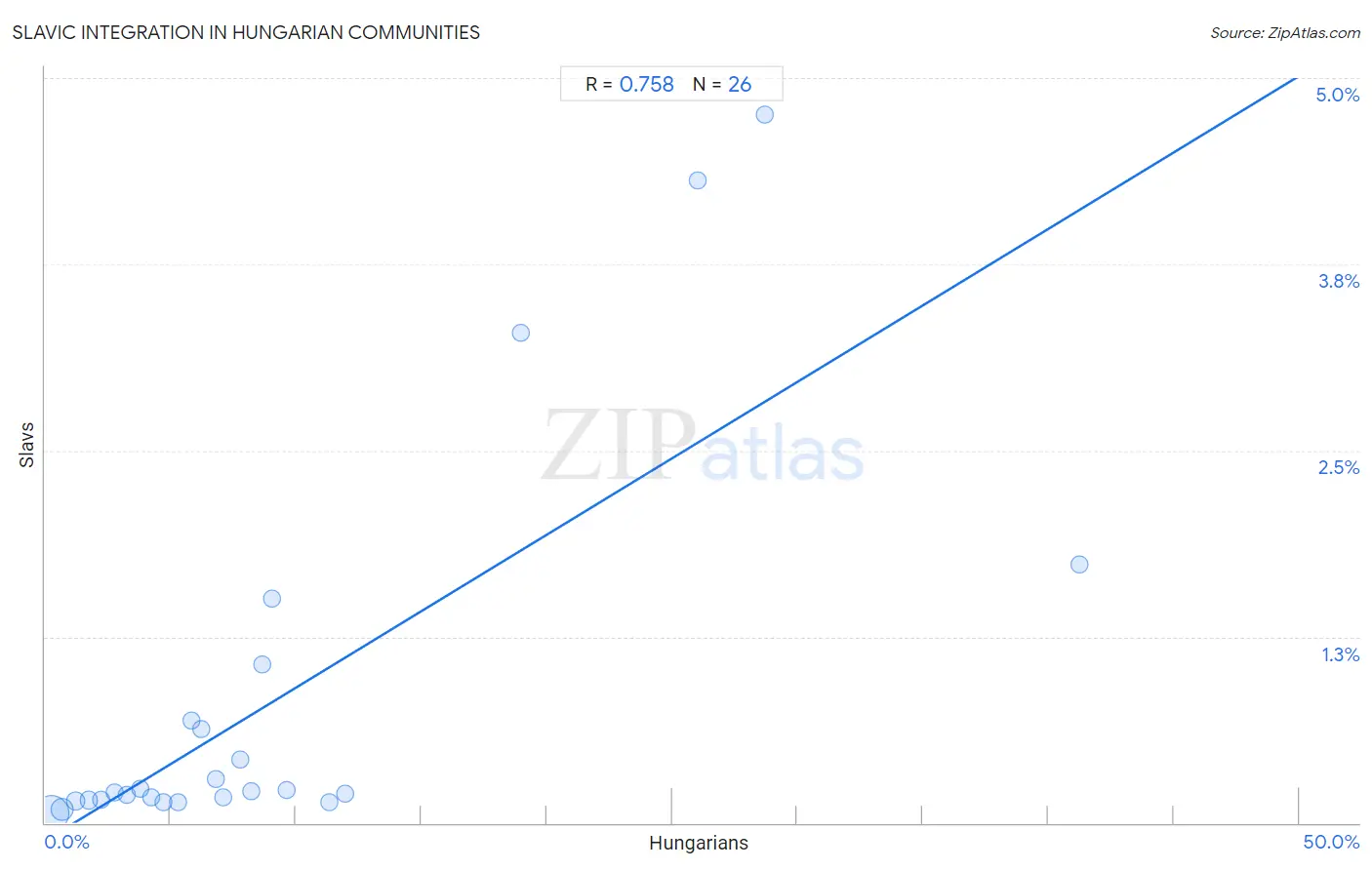
Hungarian vs Slavic Income
When considering income, the most significant differences between Hungarian and Slavic communities in the United States are seen in wage/income gap (29.0% compared to 27.4%, a difference of 5.8%), median male earnings ($57,309 compared to $56,390, a difference of 1.6%), and householder income ages 45 - 64 years ($103,913 compared to $102,629, a difference of 1.3%). Conversely, both communities are more comparable in terms of householder income over 65 years ($61,673 compared to $61,709, a difference of 0.060%), median female earnings ($39,510 compared to $39,613, a difference of 0.26%), and median family income ($105,609 compared to $105,144, a difference of 0.44%).

| Income Metric | Hungarian | Slavic |
| Per Capita Income | Excellent $45,426 | Excellent $45,049 |
| Median Family Income | Excellent $105,609 | Good $105,144 |
| Median Household Income | Good $86,920 | Good $86,398 |
| Median Earnings | Excellent $47,795 | Excellent $47,470 |
| Median Male Earnings | Exceptional $57,309 | Excellent $56,390 |
| Median Female Earnings | Average $39,510 | Average $39,613 |
| Householder Age | Under 25 years | Tragic $50,247 | Tragic $50,563 |
| Householder Age | 25 - 44 years | Excellent $97,544 | Good $96,377 |
| Householder Age | 45 - 64 years | Excellent $103,913 | Good $102,629 |
| Householder Age | Over 65 years | Good $61,673 | Good $61,709 |
| Wage/Income Gap | Tragic 29.0% | Tragic 27.4% |
Hungarian vs Slavic Poverty
When considering poverty, the most significant differences between Hungarian and Slavic communities in the United States are seen in married-couple family poverty (5.3% compared to 4.4%, a difference of 19.5%), family poverty (8.8% compared to 8.1%, a difference of 8.6%), and female poverty among 25-34 year olds (14.1% compared to 13.2%, a difference of 6.7%). Conversely, both communities are more comparable in terms of seniors poverty over the age of 75 (11.2% compared to 11.2%, a difference of 0.010%), single female poverty (21.1% compared to 21.1%, a difference of 0.060%), and seniors poverty over the age of 65 (9.7% compared to 9.8%, a difference of 0.61%).
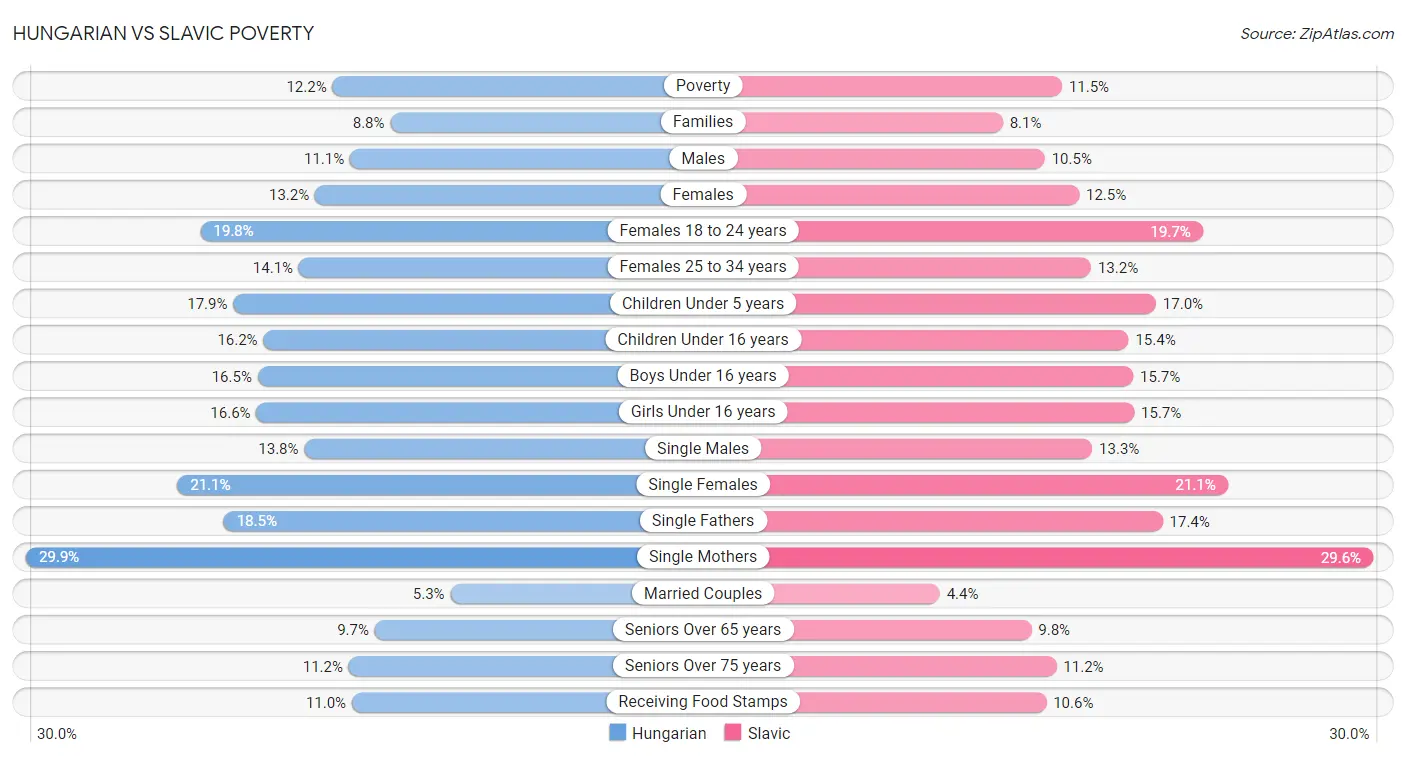
| Poverty Metric | Hungarian | Slavic |
| Poverty | Good 12.2% | Exceptional 11.5% |
| Families | Good 8.8% | Exceptional 8.1% |
| Males | Average 11.1% | Exceptional 10.5% |
| Females | Good 13.2% | Exceptional 12.5% |
| Females 18 to 24 years | Good 19.8% | Excellent 19.7% |
| Females 25 to 34 years | Poor 14.1% | Good 13.2% |
| Children Under 5 years | Poor 17.9% | Good 17.0% |
| Children Under 16 years | Average 16.2% | Excellent 15.4% |
| Boys Under 16 years | Average 16.5% | Excellent 15.7% |
| Girls Under 16 years | Average 16.6% | Excellent 15.7% |
| Single Males | Tragic 13.8% | Tragic 13.3% |
| Single Females | Fair 21.1% | Average 21.1% |
| Single Fathers | Tragic 18.5% | Tragic 17.4% |
| Single Mothers | Poor 29.9% | Fair 29.6% |
| Married Couples | Fair 5.3% | Exceptional 4.4% |
| Seniors Over 65 years | Exceptional 9.7% | Exceptional 9.8% |
| Seniors Over 75 years | Exceptional 11.2% | Exceptional 11.2% |
| Receiving Food Stamps | Excellent 11.0% | Exceptional 10.6% |
Hungarian vs Slavic Unemployment
When considering unemployment, the most significant differences between Hungarian and Slavic communities in the United States are seen in unemployment among seniors over 75 years (10.1% compared to 9.2%, a difference of 10.1%), unemployment among women with children ages 6 to 17 years (9.3% compared to 8.7%, a difference of 6.8%), and unemployment among ages 65 to 74 years (5.5% compared to 5.2%, a difference of 6.4%). Conversely, both communities are more comparable in terms of unemployment among women with children under 18 years (5.3% compared to 5.2%, a difference of 0.33%), unemployment among ages 35 to 44 years (4.6% compared to 4.6%, a difference of 0.82%), and unemployment among ages 30 to 34 years (5.5% compared to 5.5%, a difference of 0.91%).
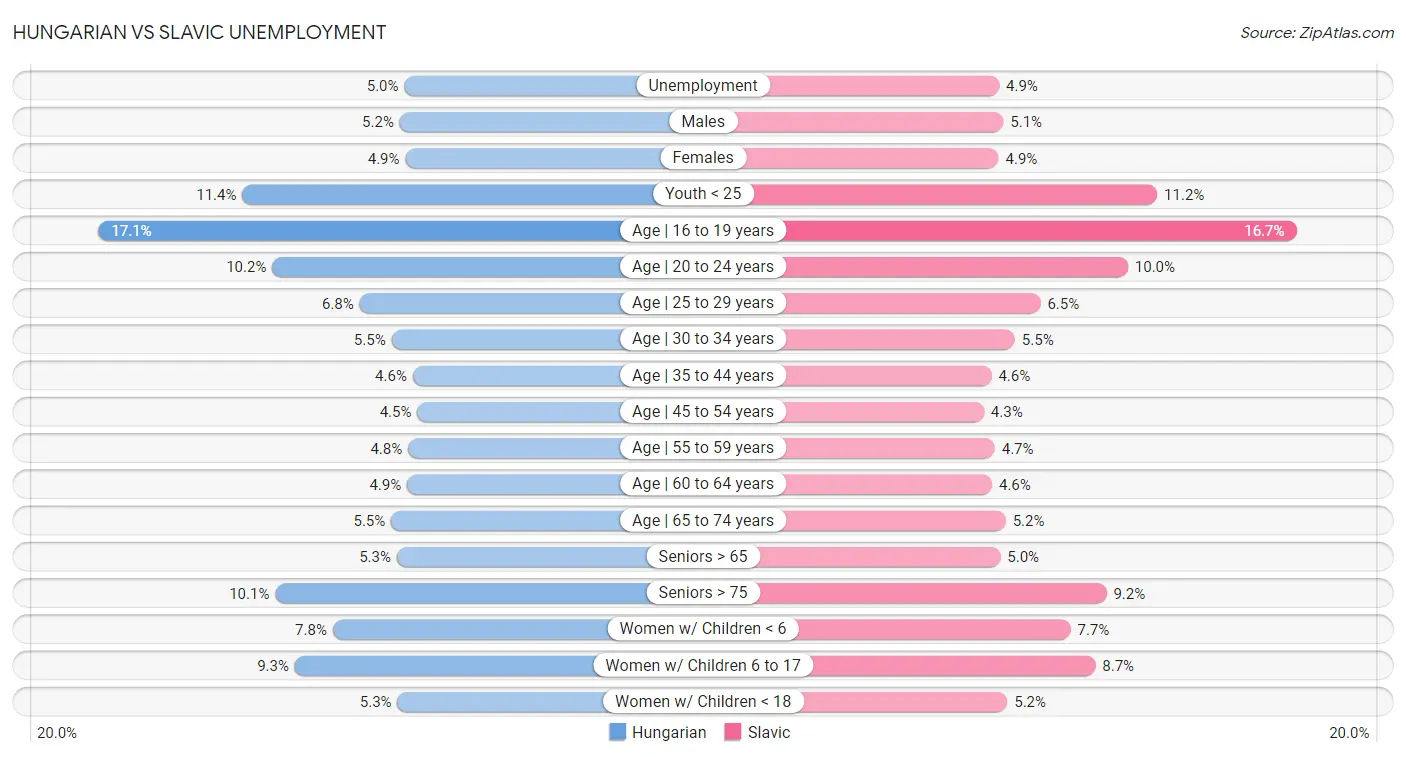
| Unemployment Metric | Hungarian | Slavic |
| Unemployment | Exceptional 5.0% | Exceptional 4.9% |
| Males | Excellent 5.2% | Exceptional 5.1% |
| Females | Exceptional 4.9% | Exceptional 4.9% |
| Youth < 25 | Excellent 11.4% | Exceptional 11.2% |
| Age | 16 to 19 years | Exceptional 17.1% | Exceptional 16.7% |
| Age | 20 to 24 years | Good 10.2% | Exceptional 10.0% |
| Age | 25 to 29 years | Fair 6.8% | Good 6.5% |
| Age | 30 to 34 years | Average 5.5% | Fair 5.5% |
| Age | 35 to 44 years | Good 4.6% | Good 4.6% |
| Age | 45 to 54 years | Good 4.5% | Exceptional 4.3% |
| Age | 55 to 59 years | Average 4.8% | Excellent 4.7% |
| Age | 60 to 64 years | Average 4.9% | Exceptional 4.6% |
| Age | 65 to 74 years | Tragic 5.5% | Exceptional 5.2% |
| Seniors > 65 | Tragic 5.3% | Exceptional 5.0% |
| Seniors > 75 | Tragic 10.1% | Tragic 9.2% |
| Women w/ Children < 6 | Fair 7.8% | Fair 7.7% |
| Women w/ Children 6 to 17 | Tragic 9.3% | Exceptional 8.7% |
| Women w/ Children < 18 | Excellent 5.3% | Excellent 5.2% |
Hungarian vs Slavic Labor Participation
When considering labor participation, the most significant differences between Hungarian and Slavic communities in the United States are seen in in labor force | age 16-19 (39.8% compared to 40.4%, a difference of 1.3%), in labor force | age > 16 (63.8% compared to 64.6%, a difference of 1.2%), and in labor force | age 20-24 (76.3% compared to 76.9%, a difference of 0.77%). Conversely, both communities are more comparable in terms of in labor force | age 45-54 (82.7% compared to 82.9%, a difference of 0.31%), in labor force | age 25-29 (84.6% compared to 85.1%, a difference of 0.51%), and in labor force | age 35-44 (84.2% compared to 84.7%, a difference of 0.53%).

| Labor Participation Metric | Hungarian | Slavic |
| In Labor Force | Age > 16 | Tragic 63.8% | Tragic 64.6% |
| In Labor Force | Age 20-64 | Tragic 79.2% | Average 79.6% |
| In Labor Force | Age 16-19 | Exceptional 39.8% | Exceptional 40.4% |
| In Labor Force | Age 20-24 | Exceptional 76.3% | Exceptional 76.9% |
| In Labor Force | Age 25-29 | Average 84.6% | Exceptional 85.1% |
| In Labor Force | Age 30-34 | Fair 84.5% | Exceptional 85.0% |
| In Labor Force | Age 35-44 | Fair 84.2% | Exceptional 84.7% |
| In Labor Force | Age 45-54 | Fair 82.7% | Good 82.9% |
Hungarian vs Slavic Family Structure
When considering family structure, the most significant differences between Hungarian and Slavic communities in the United States are seen in single father households (2.2% compared to 2.2%, a difference of 3.5%), single mother households (5.7% compared to 5.9%, a difference of 3.4%), and family households with children (27.6% compared to 26.8%, a difference of 3.0%). Conversely, both communities are more comparable in terms of currently married (48.8% compared to 48.4%, a difference of 0.97%), births to unmarried women (31.2% compared to 31.6%, a difference of 1.2%), and family households (64.9% compared to 64.0%, a difference of 1.4%).

| Family Structure Metric | Hungarian | Slavic |
| Family Households | Exceptional 64.9% | Poor 64.0% |
| Family Households with Children | Good 27.6% | Tragic 26.8% |
| Married-couple Households | Exceptional 49.1% | Exceptional 47.8% |
| Average Family Size | Tragic 3.18 | Tragic 3.13 |
| Single Father Households | Exceptional 2.2% | Excellent 2.2% |
| Single Mother Households | Exceptional 5.7% | Exceptional 5.9% |
| Currently Married | Exceptional 48.8% | Exceptional 48.4% |
| Divorced or Separated | Good 12.0% | Poor 12.2% |
| Births to Unmarried Women | Good 31.2% | Average 31.6% |
Hungarian vs Slavic Vehicle Availability
When considering vehicle availability, the most significant differences between Hungarian and Slavic communities in the United States are seen in no vehicles in household (9.9% compared to 9.0%, a difference of 10.8%), 3 or more vehicles in household (19.8% compared to 20.4%, a difference of 2.9%), and 4 or more vehicles in household (6.4% compared to 6.6%, a difference of 2.6%). Conversely, both communities are more comparable in terms of 1 or more vehicles in household (90.3% compared to 91.2%, a difference of 0.94%), 2 or more vehicles in household (56.5% compared to 57.8%, a difference of 2.3%), and 4 or more vehicles in household (6.4% compared to 6.6%, a difference of 2.6%).

| Vehicle Availability Metric | Hungarian | Slavic |
| No Vehicles Available | Excellent 9.9% | Exceptional 9.0% |
| 1+ Vehicles Available | Excellent 90.3% | Exceptional 91.2% |
| 2+ Vehicles Available | Excellent 56.5% | Exceptional 57.8% |
| 3+ Vehicles Available | Good 19.8% | Exceptional 20.4% |
| 4+ Vehicles Available | Good 6.4% | Excellent 6.6% |
Hungarian vs Slavic Education Level
When considering education level, the most significant differences between Hungarian and Slavic communities in the United States are seen in no schooling completed (1.6% compared to 1.7%, a difference of 3.6%), professional degree (4.6% compared to 4.5%, a difference of 1.9%), and associate's degree (46.7% compared to 47.6%, a difference of 1.9%). Conversely, both communities are more comparable in terms of nursery school (98.5% compared to 98.4%, a difference of 0.060%), kindergarten (98.5% compared to 98.4%, a difference of 0.060%), and 1st grade (98.4% compared to 98.4%, a difference of 0.060%).
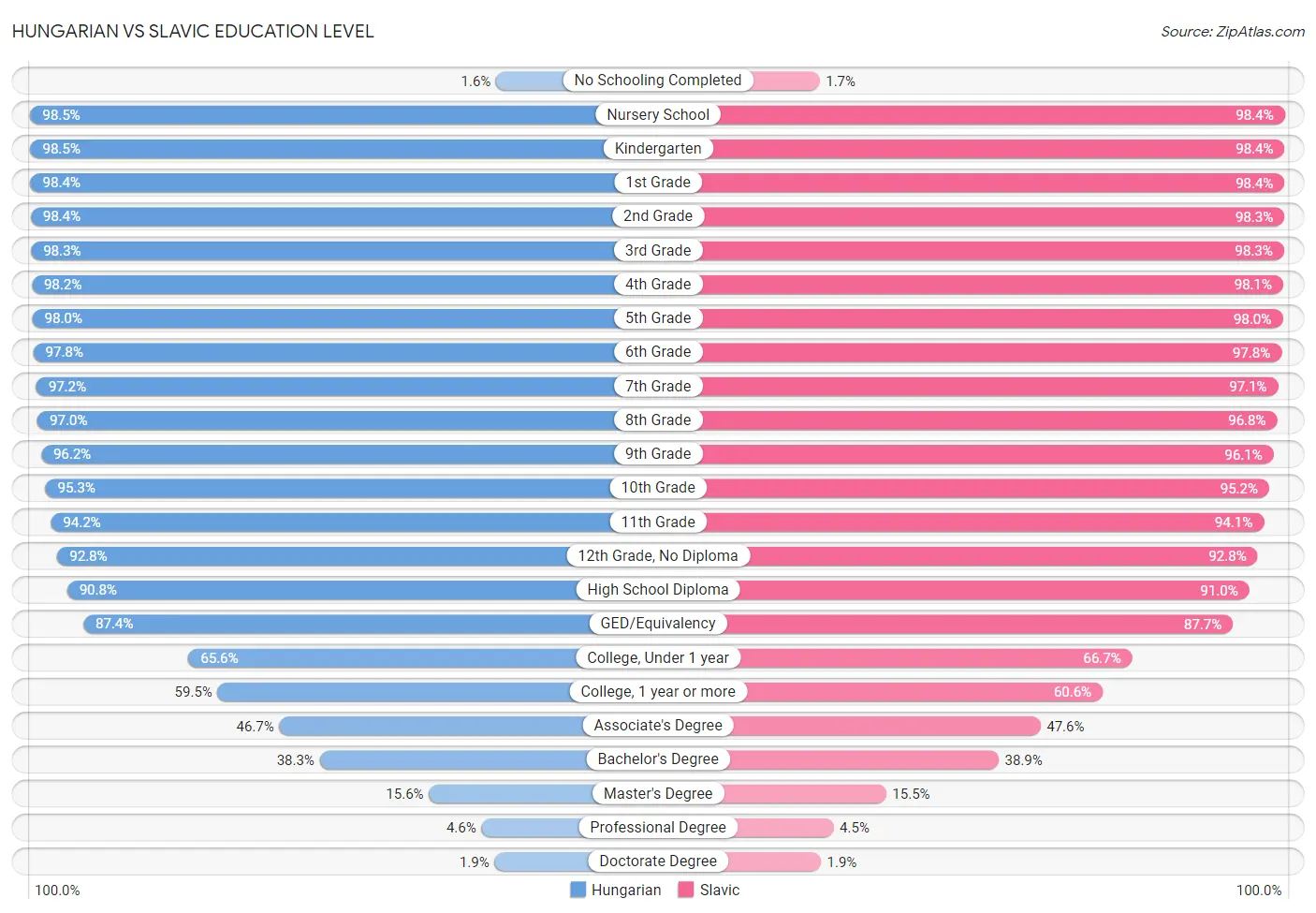
| Education Level Metric | Hungarian | Slavic |
| No Schooling Completed | Exceptional 1.6% | Exceptional 1.7% |
| Nursery School | Exceptional 98.5% | Exceptional 98.4% |
| Kindergarten | Exceptional 98.5% | Exceptional 98.4% |
| 1st Grade | Exceptional 98.4% | Exceptional 98.4% |
| 2nd Grade | Exceptional 98.4% | Exceptional 98.3% |
| 3rd Grade | Exceptional 98.3% | Exceptional 98.3% |
| 4th Grade | Exceptional 98.2% | Exceptional 98.1% |
| 5th Grade | Exceptional 98.0% | Exceptional 98.0% |
| 6th Grade | Exceptional 97.8% | Exceptional 97.8% |
| 7th Grade | Exceptional 97.2% | Exceptional 97.1% |
| 8th Grade | Exceptional 97.0% | Exceptional 96.8% |
| 9th Grade | Exceptional 96.2% | Exceptional 96.1% |
| 10th Grade | Exceptional 95.3% | Exceptional 95.2% |
| 11th Grade | Exceptional 94.2% | Exceptional 94.1% |
| 12th Grade, No Diploma | Exceptional 92.8% | Exceptional 92.8% |
| High School Diploma | Exceptional 90.8% | Exceptional 91.0% |
| GED/Equivalency | Exceptional 87.4% | Exceptional 87.7% |
| College, Under 1 year | Average 65.6% | Excellent 66.7% |
| College, 1 year or more | Average 59.5% | Excellent 60.6% |
| Associate's Degree | Average 46.7% | Excellent 47.6% |
| Bachelor's Degree | Good 38.3% | Good 38.9% |
| Master's Degree | Good 15.6% | Good 15.5% |
| Professional Degree | Excellent 4.6% | Good 4.5% |
| Doctorate Degree | Good 1.9% | Good 1.9% |
Hungarian vs Slavic Disability
When considering disability, the most significant differences between Hungarian and Slavic communities in the United States are seen in disability age under 5 (1.5% compared to 1.4%, a difference of 10.0%), disability age 18 to 34 (7.1% compared to 7.4%, a difference of 3.5%), and disability age 65 to 74 (22.4% compared to 23.0%, a difference of 2.3%). Conversely, both communities are more comparable in terms of self-care disability (2.5% compared to 2.5%, a difference of 0.56%), female disability (12.5% compared to 12.6%, a difference of 0.62%), and ambulatory disability (6.3% compared to 6.4%, a difference of 0.86%).
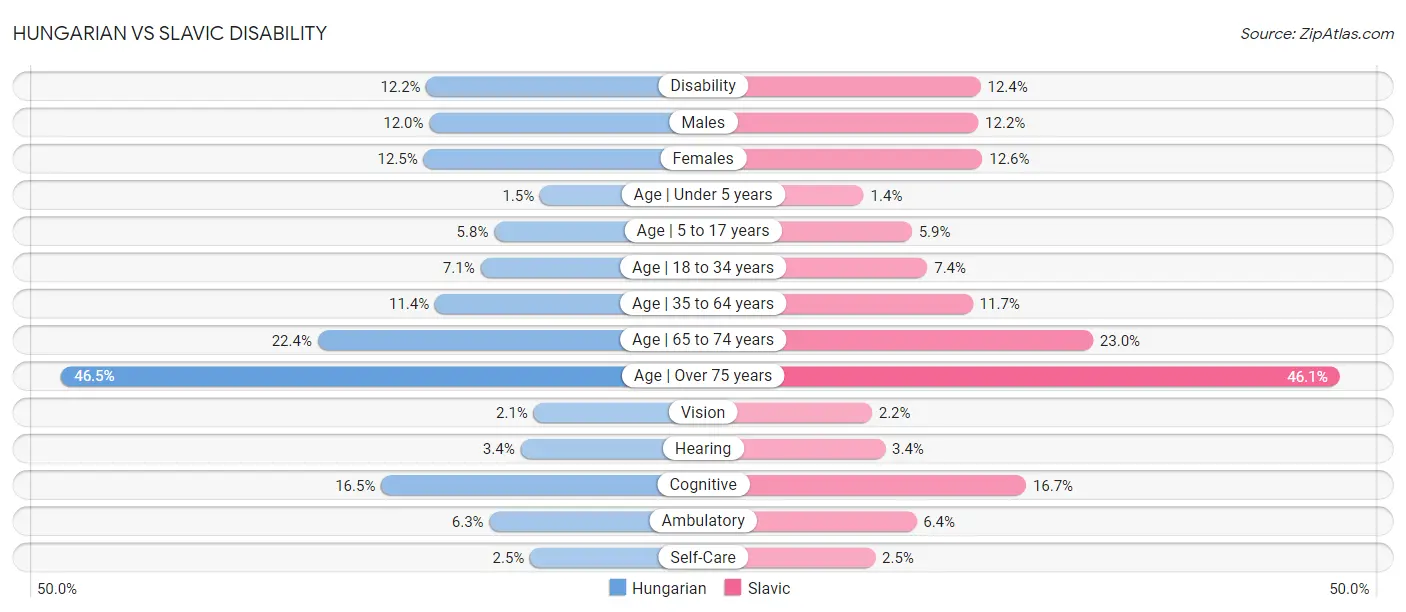
| Disability Metric | Hungarian | Slavic |
| Disability | Tragic 12.2% | Tragic 12.4% |
| Males | Tragic 12.0% | Tragic 12.2% |
| Females | Tragic 12.5% | Tragic 12.6% |
| Age | Under 5 years | Tragic 1.5% | Tragic 1.4% |
| Age | 5 to 17 years | Tragic 5.8% | Tragic 5.9% |
| Age | 18 to 34 years | Tragic 7.1% | Tragic 7.4% |
| Age | 35 to 64 years | Fair 11.4% | Poor 11.7% |
| Age | 65 to 74 years | Exceptional 22.4% | Good 23.0% |
| Age | Over 75 years | Exceptional 46.5% | Exceptional 46.1% |
| Vision | Good 2.1% | Average 2.2% |
| Hearing | Tragic 3.4% | Tragic 3.4% |
| Cognitive | Exceptional 16.5% | Exceptional 16.7% |
| Ambulatory | Tragic 6.3% | Tragic 6.4% |
| Self-Care | Average 2.5% | Fair 2.5% |